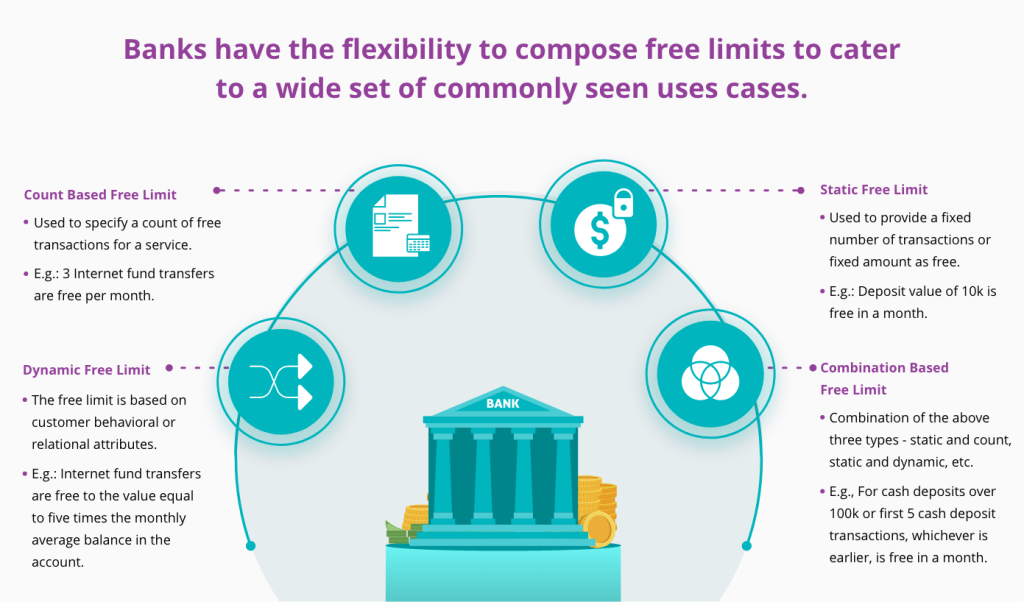Banking is not what it used to be. It is still one of the key pillars of the global economy, but the business of banking is now tougher than ever. Customers today demand value-driven and relationship-based engagement and don’t hesitate to take their business elsewhere if their expectations are not met. And they have plenty of options to choose from, as competition within the sector is at an unprecedented high. Not only are there fintechs, tech giants, and neobanks entering the field, traditional banks too are upping their game to attract and retain customers. Free limits or special packages with certain free components are an excellent way to differentiate your business from the competition and deliver a value-driven experience for your customer.
Understanding Free Limits
Free offerings have always been popular. The concept of free limits has also been in use in banking for several decades. Free limits are part of a complete package offered to customers where they can enjoy some benefits free of cost for a fixed time period or until the established limit is crossed. Once that happens the customer must pay the standard fee or negotiated fee. Free limits work well to attract new customers as well as improve customer loyalty and retention. They are a valuable tool for business promotion and for retaining the existing customer base with value-driven engagements.
Designing a Modern Free Limits Campaign
The advent of technology has given free limits a structure and improved the kinds of free limits that can be offered as well as their management. Unlike the ad hoc free limit campaigns earlier, banks today can leverage advanced technology platforms to create a range of free limit offerings, roll them out quickly, monitor usage, and monetize once the free period is over. Any number and kind of free limit offerings can be quickly built using a robust offer management solution. The limits can be set against usage-based services or recurring services. They can be volume based or time-period based and can be defined for combination of multiple services. They can even be set for specified frequencies – monthly, quarterly, yearly, and so on. The offer management platform can automate the monitoring processes and ensure that standard billing kicks off as soon as the free period is over, thus preventing any revenue leakage. And the best part is that banks don’t have to touch their legacy cores to deploy such an offer management solution – they can leverage an intelligent middle layer solution that can seamlessly sit over the legacy core to power the bank’s free limits strategy.
The Kinds of Free Limits Offers That a Bank Can Run

These functional capabilities allow banks to define several possible use cases of free limits offerings. Below are some examples banks have successfully implemented.
Free Withdrawals Against a Product
This can be time bound, such as four free cash withdrawals per month for a specified product. The time frame can even be set to daily, such as free cash withdrawal up to USD50,000 per day. It can also be value based – free cash withdrawal up to USD100 per month for a product. And it can serve to bring in customers to try a new product by offering 20 free cash withdrawals for three months after launch. It can be linked to the customers’ monthly average balance – cash withdrawals equal to 25 percent of the monthly average balance are offered free. They can define maximum and minimum limits – free cash withdrawals up to 10 times the monthly average balance with a maximum limit of USD10 million or with a minimum balance of USD6 million. Banks can choose to offer a combination of value and volume based free limits such as 3 free cash withdrawals or total withdrawals of USD100 as well. Banks can also choose to offer free subscriptions such as the first two months of subscription free for cash withdrawals.
Free Deposits
There are multiple use cases of free limits set on deposits. For example, a bank offered 25 free cash deposits of total cash deposit of USD25 million which ever was consumed first for deposit (base) and non-base services. They can link free limits to desirable customer behavior such as free cash deposits of up to USD20 million can be offered only if the customer maintains 75 percent of the account’s monthly or quarterly average balance.
Free Limits on ATM Usage
Most traditional banks have extensive ATM networks and free limits are a good way to drive footfalls and usage. They can use free limits to drive usage in specific geographies and for specific kinds of transactions as well. A bank can offer the first five financial ATM transactions free of cost for a month. Or the first 10 non-financial ATM transactions free of cost for a month but applicable to ATMs in metros only. It can also offer a combination of 5 financial and 10 non-financial tractions free for a month at non-metro ATMs.
Free Limits for Customer Segments
Banks can segment customers into broad groups – such as farmers from a certain region – and offer them the same free limits as mentioned above over a period or for a certain set value.
Other Service Based Free Limits
Free limits can be defined for specific services such as Bulk Note Acceptor (BNA) cash deposits where a bank can offer BNA cash deposits at a discount or the first two transactions during holidays or non-banking hours for free. They can offer fair usage free limit for a combination of branch services such as remittance, NEFT/ RTGS, outward clearing and more. They can offer free DD/ PO issuing services against maintenance of a specified monthly average balance and they can offer free cheque leaves per year for a specific product.
Carryovers
Banks can also offer carryover services for their free limits. For example, a bank can offer 10 free cash deposits in a month for their savings account customers. They can allow customers to use each month’s unused free transactions within the next three months after which they will expire. A robust offer management platform can facilitate two kinds of carryover approaches. In the first one, the carryover free limit is consumed before the current ones can be used. This ensures that any carryover free limits are availed of before they expire. In the second, the current free limit must be used before the carryover one can be used.
Free limits have been used by the banking world for several years. But as competition heats up, they must focus on improving the kind of free limit offers they present customers as well as ensuring that the free limit campaign is run effectively and efficiently. None of these are possible without a robust offer management solution and banks must prioritize their technology roadmap if they want to stay ahead of competition and grow their customer base and revenues.



